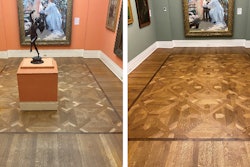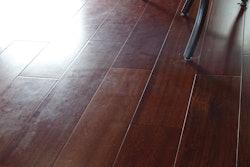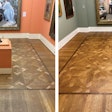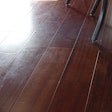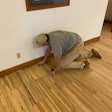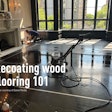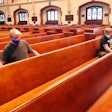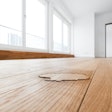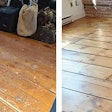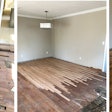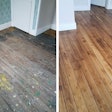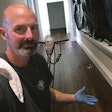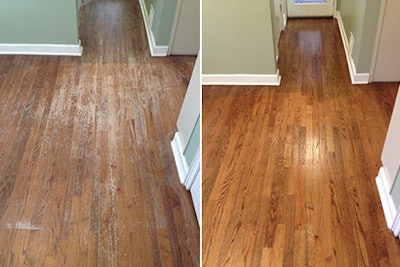
Recoating wood floors is a great option for finishes going through a midlife crisis. Quick and clean, it is still gaining in popularity and acceptance with homeowners. Those of us who have been in the industry for awhile have seen a noticeable spike in interest since a couple of manufacturers of waterborne finishes started promoting it, as they saw an expanding recoating market and started putting products out there to support it. These products include liquid cleaners, synthetic pads, test kits for acrylic waxes, auto scrubbers and bonding agents needed to prep an old finish and promote adhesion. The process has evolved dramatically over the last 10 years.
However, recoating has an identity problem that needs to be faced. Contractors, decorators, real estate agents, designers, etc., don't talk about "recoating" a wood floor. They talk about "screen and recoat." The term "screen" refers to using a screen-backed disc (worn, in most cases) to prep the floor prior to applying a fresh coat of finish. That's an option if the finish is new. However, if the finish has years of use and layers of dirt and grime, just screening old finish without cleaning it first will increase the potential for problems and even failure. In essence, if all you're doing is screening a floor without a deep cleaning prior to recoating, your chances for failure skyrocket.
Fighting Old Habits
Old habits die hard and, understandably, some contractors don't agree with me. First, they apply the old adage, "It ain't broke, so don't fix it," and continue to just screen and recoat without bothering to clean. That old adage may sometimes be true, but only if the surface being worked on is a new finish. If you are working on traditional sand/stain/finish projects, using worn screens for abrasion between finish coats, that's one thing. But it is a game changer when the finish is old and has dirt, grime and filth layered on top of it from years of use. Screens, new or worn, were never designed, sold or promoted as being able to clean a dirty floor. More importantly, I have never seen any manufacturer suggest that, either.
Second, some contractors feel the deep cleaning process recommended by finish manufacturers promoting recoating processes is more of a maintenance or janitorial function and out of their comfort zone. However, all the manufacturers promoting recoating have good education/training videos and workshops, so there is plenty of support. Indeed, the cleaning process prior to recoating is some of the most well-thought-out wood flooring technology on the market today.
Educating the Public
The solution for my company was a campaign to educate clients and the public. I started by writing blogs for my website explaining the recoating process and how it has evolved. This expanded to placing some articles in local newspapers. More recently, I hired a videographer and we put out a video entitled "Clean & Recoat." I sent the video out in email blasts to former and potential clients instead of trying to explain it on the phone. I've put it on my website. In the video I take people onto a jobsite and walk them through the process, step by step. I pause the action to discuss the difference between using a screen versus the maroon pad in the recoating process, and I don't mince my words. I call a screen a dinosaur if you intend to use it for cleaning a wood floor, and it is an easy point to make. My objective was simple: rebrand this process. As one thoughtful client put it, "Are you going to clean a dirty casserole dish with fine, worn sandpaper or a scrubbing pad using soap and water?" I think the answer to that question is, "Duh!"
The public is ready for the concept of "clean and recoat," and my campaign to educate them has paid off in spades. They totally get refurbishing an old finish as opposed to completely sanding and finishing to improve a floor's appearance. Whether you use the cleaning chemicals available, bonding agents or autoscrubbers, your potential for success is better than ever. My personal choice are deep cleaners sold by a finish company, synthetic pads and my old reliable buffer. I also go to great lengths to tell my clients what recoating will and won't accomplish, so their expectations are reasonable. It has its limits, and I make sure everyone understands that.
Moving Forward
The wood flooring business we have today bears little resemblance to what it was when my dad went into it around 1947 or when I started my business in 1973. The work has always been challenging, but changes in machinery, stains, finishes and other materials have improved the quality and consistency of our work. The same can be said for recoating to the point that today I no longer offer traditional sanding/finishing. As an old geezer packing a Medicare card, my clean and recoat business offers me a great (and highly profitable) alternative to use my skills in my waning years.
The term "screen and recoat" needs to be in our rearview mirror, because it sure isn't on the horizon. It represents a process far more likely to create problems than solve them. Promoting cleaning and recoating a floor offers a more stable approach, greater rewards for your company and your client, and a brighter future for our evolving trade.
The Floor Listener: Wood Floors Have Stories to Tell
What the Wood Flooring Industry Can Learn From the Tower of Babel
See all of Michael Purser's popular blog posts and magazine articles here.
















